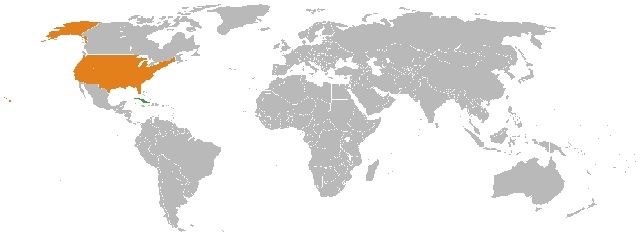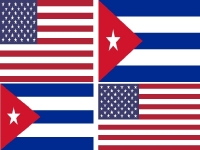Travel
U.S. CUBA SIGNED AGREEMENT TO PROTECT THE VAST ARRAY OF FISH & CORALS THEY SHARE
NATIONAL SANCTUARIES IN FLORIDA & TEXAS

USA in Orange & CUBA in Green
The United States and Cuba are set to reach their first accord on environmental protection since announcing plans to re-establish diplomatic relations, linking up marine sanctuaries in both countries to cooperate on preservation and research.
'We recognize we all share the same ocean and face the same challenges of understanding, managing, and conserving critical marine resources for future generations,' said Kathryn Sullivan, chief of the U.S. National Oceanic and Atmospheric Administration.
The memorandum signed by U.S. and Cuban officials in Havana directs scientists with the Florida Keys and the Texas Flower Garden Banks national sanctuaries to collaborate with researchers at two similarly fragile and protected reserves: Guanahacabibes National Park and the Banco de San Antonio, located on the island's westernmost region.
Ocean currents carry many of the same fish and organisms off the coast of Cuba into the Gulf of Mexico and the Atlantic Ocean, making collaboration on topics like preservation and sustainability an area of mutual interest for scientists in both countries.
Ocean currents carry many of the same fish and organisms off the coast of Cuba into the Gulf of Mexico and the Atlantic Ocean, making collaboration on topics like preservation and sustainability an area of mutual interest for scientists in both countries.
Environmental cooperation has been one of the most visible areas of progress in the relationship as the United States and Cuba negotiate and discuss a number of issues. They include much thornier matters on which the two countries remain far apart, such as the U.S. embargo and the naval base at Guantanamo, as well as Cuba's record on rights and democracy.
U.S. Secretary of State John Kerry announced in October that the countries were working on a marine-preservation accord. That same month, Cuba and the U.S.-based Environmental Defense Fund unveiled an initiative designed to protect shark populations, record fishing vessel catches and develop a long-term conservation plan. And in April, NOAA and Cuban scientists circled the island on a research cruise to study the larvae of bluefin tuna, a highly threatened and commercially valuable species.
Cuba's marine ecosystem is considered one of the best preserved in the region, with large reserves of relatively untouched coral and large populations of fish, sharks and sea turtles. But such ecosystems could come under new threats as Cuba continues to search for offshore oil and tourism booms.
Guanahacabibes National Park is one of Cuba's largest and most isolated reserves. It is home to a large population of sea turtles, spiny lobsters and contains what is considered one of Cuba's most robust coral reefs. It is still out of reach for many tourists, though more travelers and boats are beginning to arrive.
Source : AP
Ruby BIRD
http://www.portfolio.uspa24.com/
Yasmina BEDDOU
http://www.yasmina-beddou.uspa24.com/
Guanahacabibes National Park is one of Cuba's largest and most isolated reserves. It is home to a large population of sea turtles, spiny lobsters and contains what is considered one of Cuba's most robust coral reefs. It is still out of reach for many tourists, though more travelers and boats are beginning to arrive.
Source : AP
Ruby BIRD
http://www.portfolio.uspa24.com/
Yasmina BEDDOU
http://www.yasmina-beddou.uspa24.com/
Ruby Bird Havana Washington Florida Texas Agreement Protect Vast Array Fish Corals Share Marine Conservation Research Ecosystems Guanahacabibes National Park The Banco De San Antonio
Liability for this article lies with the author, who also holds the copyright. Editorial content from USPA may be quoted on other websites as long as the quote comprises no more than 5% of the entire text, is marked as such and the source is named (via hyperlink).






